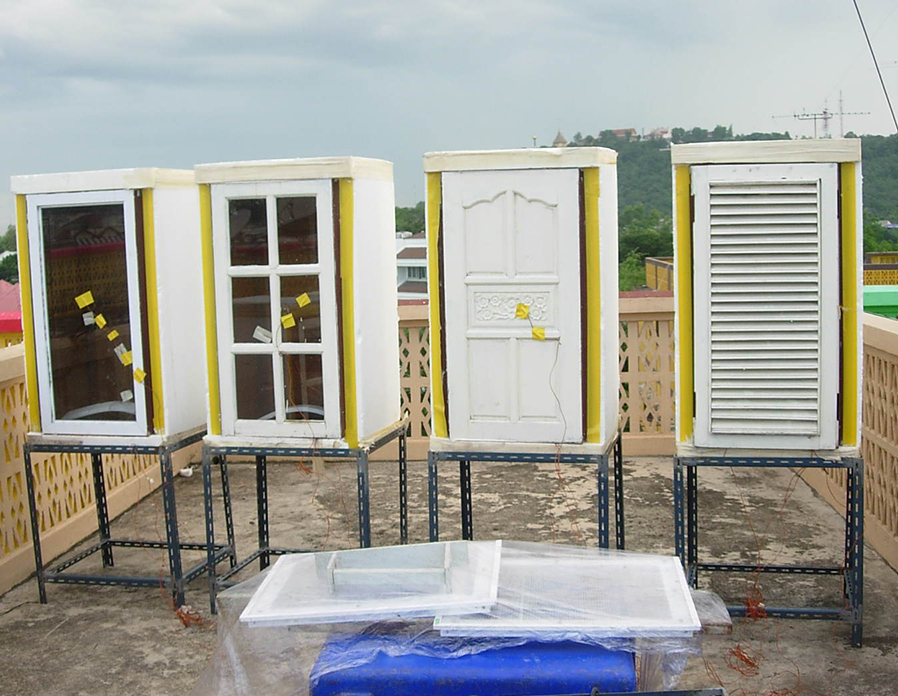Investigating Influence of Different Materials on Window Thermal Performance
Main Article Content
Abstract
This study is an experimental research study in order to find the effectiveness of the heat transfer and to compare the temperature behaviors of the windows with different layers made of various materials. The windows were divided into four types: 1) clear glass window with aluminum frames, 2) clear glass window with wooden frames, 3) wooden window, and 4) double layered window with a clear glass and aluminum sliding window (the inner layer) and a wooden louvered window (the outer layer). In this study, the heat transfer values of the materials were analyzed. The temperatures of the air and material surfaces were checked. The size of the created prototype was 1.00 x 0.50 meters installed in the test box that had foam insulation on its five sides. Data were recorded for 24 hours.
The results show that the heat resistance of the wooden materials was approximately 1.4 times higher than the glass materials. The air temperatures inside all test boxes were higher than that of the surrounding air. The highest air temperatures inside the test boxes were 36.5 - 56.7 °C during 01.00 p.m. – 02.40 p.m. The lowest air temperature was 25 °C at 06.00 a.m. The clear glass window with aluminum frames had the highest temperature in the test box and the highest difference between the temperatures at day and night. The double layered window had the lowest difference. Finally, it can be concluded that the double layered window could effectively protect heat transferring into the buildings, reduce the cooling load, and facilitate energy conservation
Downloads
Article Details

This work is licensed under a Creative Commons Attribution-NonCommercial-NoDerivatives 4.0 International License.
All material is licensed under the terms of the Creative Commons Attribution 4.0 International (CC-BY-NC-ND 4.0) License, unless otherwise stated. As such, authors are free to share, copy, and redistribute the material in any medium or format. The authors must give appropriate credit, provide a link to the license, and indicate if changes were made. The authors may do so in any reasonable manner, but not in any way that suggests the licensor endorses you or your use. The authors may not use the material for commercial purposes. If the authors remix, transform, or build upon the material, they may not distribute the modified material, unless permission is obtained from JARS. Final, accepted versions of the paper may be posted on third party repositories, provided appropriate acknowledgement to the original source is clearly noted.
References
Misiopecki, C., Gustavsen, A. & Jelle, B. P. (2013). Investigating influence of different shading devices on window thermal performance. Paper presented in the 13th Conference of International Building Performance Simulation Association, Chambery, August 26-28, France.
Arasteh, D., Griffith, B. & LaBerge, P. (1994). Integrated window systems: An advanced energy-efficient residential fenestration product. The proceeding in The 19th national passive solar conference, June 25- 30, American Solar Energy Society, Inc.
Kragh, J. (2008). Energy gaining windows for residential buildings, paper presented in the 8th Nordic Symposium. Session W4A-Windows and Facades, 1173-1180.
Petchdee, P. & Chungloo, S. (2013). Improvement of louvers and openings of factory building to remove heat through natural wind. Journal of Architectural/Planning Research and Studies, 10(2), 31-44.
Sudprasert, S. & Klinsmith, S. (2014). Assessment of overall thermal transfer value (OTTV) in buildings. Journal of Architectural/Planning Research and Studies, 11(1), 109-118.
Srisutapan, A. (2009). การประเมินสมรรถนะด้านพลังงานของอาคาร: มหาวิทยาลัยธรรมศาสตร์ ศูนย์รังสิต [The Assessment of Building Energy Performance: Thammasat University, Rangsit Campus]. Journal of Architectural/Planning Research and Studies, 6(1), 14-29.
Theppipit, J. & Jindavanig, T. (2013). เปรียบเทียบประสิทธิผลระหว่างค่าสัมประสิทธิ์การถ่ายเทความร้อนที่ส่งผ่านกระจกกับค่าสัมประสิทธิ์การบังแดดของอุปกรณ์บังแดด [The Comparison of effective shading coefficient between glazing glass and shading device]. Journal of Energy Research, 10(2), 32-44.
Yanachai, K., Khuhaprema, T. & Wayupak, P. (2009). การศึกษาการลดภาระความร้อน จากอุปกรณ์บังแดดภายนอกอาคารในพื้นที่หน้าต่างกระจกเพื่อการประหยัดพลังงานไฟฟ้าในเครื่องปรับอากาศ: กรณีศึกษา ห้องสมุดชั้นสองอาคารสันทนาการ สถาบันมะเร็งแห่งชาติ [A study of load reduction by outside shading device on the fenestration area for electrical saveing in air conditioning: Case study library on 2nd floor, sunthanakarn building, National Cancer Institute]. Journal of Srinakharinwirot University (Science and Technology), 1(2), 40-41.


